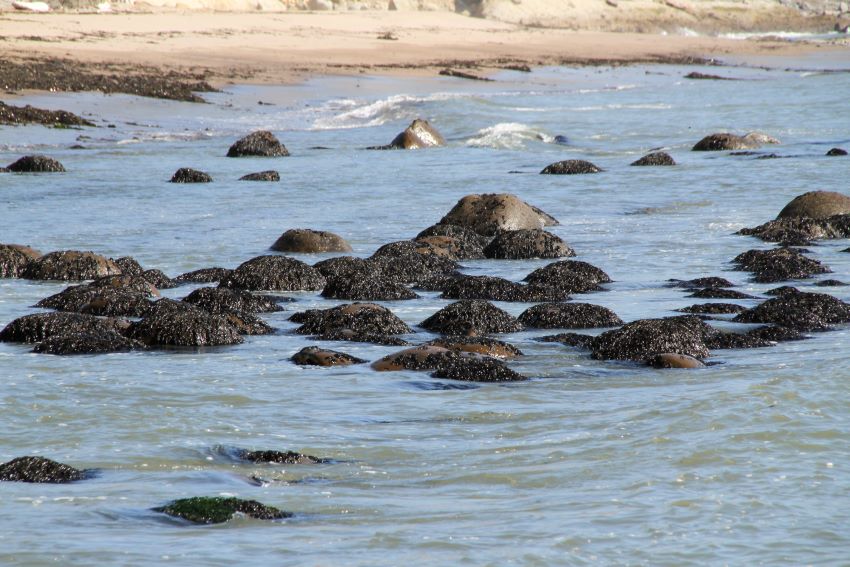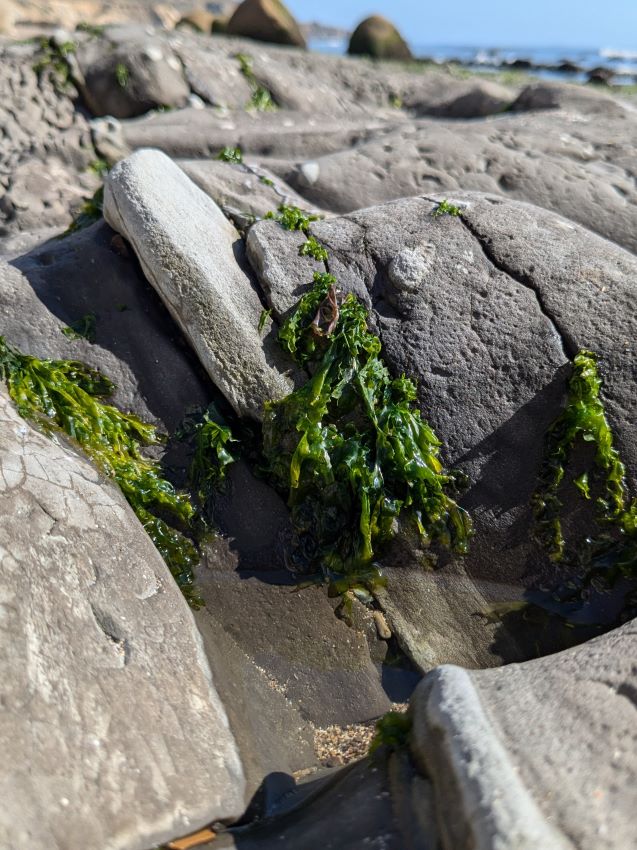Today I'm taking you to another beach in Mendocino County that we visited twice during our long weekend in Gualala. This beach has been on my list for several years, however, it is quite hidden and not easy to find. You really have to know the mile marker on Highway 1 to then find some parking off the highway. Fortunately there is a very small dusty parking strip near Schooner Gulch State Beach from where we took the narrow trail through the meadows to the bluff edge.
The trail was easy enough until you have to get down the bluff. The very last bit is the most challenging one. I admit, I just got on my butt to get down to the beach over the rocky cliff.
The beach is secluded and there was almost no one there.
Look at this - can you see the rocks in the water? That's why we're here.
Let's get a bit closer.
These are the "bowling balls" that gave the beach its name.
So, what are they and how did they get here?
They are spherical sandstone concretions. Concretions are small pockets of extra-tough stone that formed inside sedimentary rock millions of years ago. Ocean waves crashed and carved away at the softer sedimentary rock on the outside, leaving the concretions behind. Some of these bowling ball concretions are even peeking out from the sedimentary rock cliffs.
The bowling ball boulders can only be seen at low tide. When we got here, it was not a zero low tide when they are completely out of the water. But it was still impressive enough. As you can see, a lot of seaweed resides on these boulders.
This is a fantastic place for a geology nerd which I am unfortunately not. A lot of questions are still unanswered for me whereas for some I guessed a pretty logical answer.
Look at these ruts:
We are just a few miles South of where the infamous San Andreas Fault dives into the Pacific Ocean and there you can see a very similar pattern. I guess that all these ruts are related to the fault.
More ruts and boulders...
The beach was fascinating outside the water as well. No matter where you looked, there was something mesmerizing to discover.
I particularly liked this interesting formation.
There were so many bigger and tiny things to find on the beach - shells, pieces of abalone shells, a bat star (Patiria miniata) and a Gumboot chiton.
Seaweed was everywhere.
Since the tide was coming in, it was time to go. Halfway up the bluff, there was onle last view back to this hidden gem of a beach.
Two days later, very early in the morning, there was a zero tide. That was a very different experience. Stay tuned...






















What a fascinating (and beautiful) place. I am really looking forward to the next installment.
ReplyDelete...geology is a fascinating thing!
ReplyDeleteWhat a fabulous spot, Carola. The fact that it is hard to get to is a real bonus, since it does not get flooded with beach goers. I would be scavenging and collecting right along with you. So much to see, so much to learn, so much to experience. I think, however, that you should have asked The Geek to take a picture of you scudding down on your butt. We would all have enjoyed that! Big hugs - David
ReplyDeleteA beautiful place and I am looking forward to more!
ReplyDeleteThose boulders in the surf were quite amazing to see, Carola, and in fact all the photos of the water and cliffs were beautiful. I would also have found that descent a bit tricky.
ReplyDeleteThis looks like it was your own private beach. And I love the geology.Those concretions are cool. I find geology fascinating, even though I don't know all that much about it. Have a great rest of your week Carola. hugs-Erika
ReplyDeleteQue lugar tan maravilloso, me habría encantado estar ahí, pero todavía no habría podido bajar a la playa. Me alegra que disfrutaran. Un abrazo.
ReplyDeleteSuch a fabulous beach, so pleased you visited and shared these wonderful photographs.
ReplyDeleteAll the best Jan